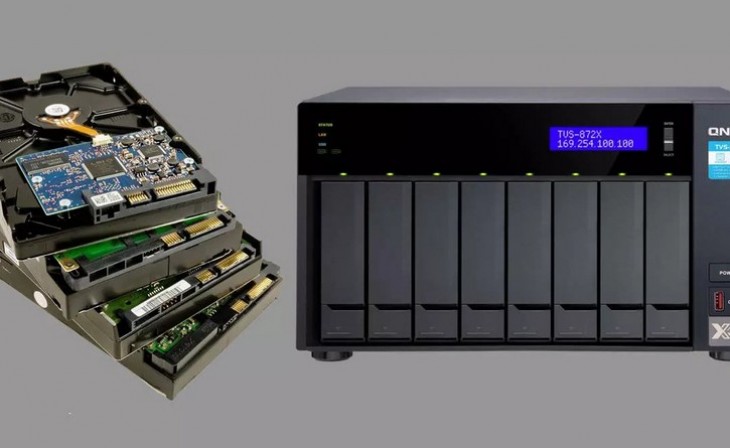How many bays must a home NAS have to configure a RAID?
What is a RAID and which ones can I configure on my NAS?
A RAID system (Redundant Array of Independent Disks) or also known as a redundant group of independent disks, provides us with an information storage system using different hard drives or SSDs, among which the information is distributed or the data is replicated, with the objective of providing security when a disc breaks. Depending on the RAID chosen when creating a storage pool, we will have different strengths: greater data integrity, tolerance against faults on one or more disks, faster reading speed, and faster writing speed. Of course, depending on the RAID that we are going to configure, we will have a different final capacity, so we must also take it into account.
In domestic environments, the most normal thing is that users have a NAS server between 2 and 4 bays to house hard drives, therefore, it is very common for us to configure a RAID with a minimum of two disks and a maximum of four disks. In the event that our NAS server has two bays to host hard drives, we will be able to configure the following RAIDs:
- RAID 0: Also called " data striping ", all data is distributed evenly on the two-member hard drives of the RAID, there is no parity information to provide redundancy. In the case of an error in either of the two disks, we would automatically lose all the information, because the data is distributed on both disks. Thanks to a RAID 0 we will have twice the speed of reading and writing compared to if we had a disk because we will be reading and writing simultaneously in two. Regarding capacity, it is the sum of the capacity of the two hard drives, assuming that both drives have the same capacity.
- RAID 1: also called " mirror ", in this type of RAID all data is duplicated on both hard drives, that is, exactly the same information is written on both drives. In this case, there is no parity information, because the data is replicated on both disks. In the event of an error on either disk, the information would still be safe on the other disk, because we have a "copy." Thanks to a RAID 1 we will have twice the reading speed because we can read information from both disks simultaneously, but the writing is as if it were done on one disk only. Regarding capacity, it is the capacity of one of the hard drives, assuming that both drives have the same capacity.
In the event that your NAS server incorporates three bays to host hard drives, in addition to being able to configure RAID 0 or RAID 1 with two disks, we could also configure one of the most used RAIDs, RAID 5.
- RAID 5: in this type of RAID we will need at least a total of three hard drives. In this type of RAID, the information will be distributed over all the disks, in addition, we will have parity information for all the disks in the storage set. In the case of an error in any of the three disks, we can automatically regenerate all the information when we change the disk that has broken, thanks to the parity information. Thanks to a RAID 5, we will have (number of disks - 1) more reading speed, in the case of three disks we will have twice the speed, in the case of four disks we will have three times the speed. The writing speed will be the speed as if we had a single disc. Regarding the capacity, it is the sum of the capacity (number of disks - 1), because we have "one disk" of parity,
If the NAS server has four bays to host hard drives, we can configure the previous RAIDs, but we can also configure the following:
- RAID 6: in this type of RAID we need at least a total of four hard drives, in this case, we will have two drives as "parity", that is, we will have double parity. We can recover the information even if two of the four discs break. Thanks to a RAID 6, we will have (number of disks - 2) more reading speed, in the case of four disks we will have twice the speed, in the case of five disks we will have three times the speed. The writing speed will be the speed as if we had a single disc. Regarding capacity, it is the sum of capacity (number of disks - 2), because we have "two disks" of parity, although double parity is distributed across all disks.
- RAID 10: This type of RAID is very interesting because it is not necessary to do the parity calculation, therefore, the performance is excellent. This type of RAID allows us to create a RAID 0 out of two RAID 1s, in this way, a disk of each group can be broken without any problem, the information can be regenerated again, and all without parity. Of course, if the two discs are broken in a group, we will lose all the information. So if the "second" disc breaks where it shouldn't, we will lose everything. For this reason, if you want higher performance RAID 10 is ideal, but if you want greater security for your data then RAID 6 should be your option. Thanks to a RAID 10, we will have four times the reading speed, and twice the writing speed. Regarding the capacity, it is the sum of the capacity (number of disks - 2),
As you have seen, the NAS with few bays can configure RAID 0 or RAID 1, in the case of three or more bays we can choose RAID 5, and if we have at least four bays, we can configure RAID 6 or RAID 10.




